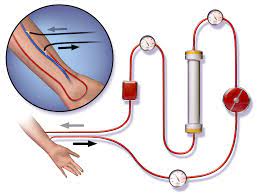hemodialysis access Santa Fe

Hemodialysis is a medical treatment used to remove excess waste products and fluids from the blood of people whose kidneys are not functioning properly. It is typically performed in a hospital or dialysis center and requires access to a patient’s bloodstream. There are several different types of hemodialysis access, including:
- Arteriovenous (AV) fistula: This is the most common type of hemodialysis access. It is created by surgically connecting an artery to a vein in the arm or leg, forming a direct path for the blood to flow from the artery to the vein and back again.
- Arteriovenous (AV) graft: This type of hemodialysis access is similar to an AV fistula, but instead of using the patient’s own veins, a synthetic tube (graft) is used to connect an artery to a vein.
- Catheter: A catheter is a long, thin tube that is inserted through a small incision in the neck, chest, or groin and passed through a vein to the heart. It is used as a temporary measure while waiting for a more permanent access method to be established.
In Santa Fe, New Mexico, there are several hospitals and dialysis centers that offer hemodialysis treatment and access options. It is important to discuss your specific needs and treatment options with your healthcare provider to determine the best approach for you.
What Is hemodialysis access Santa Fe?
Hemodialysis access in Santa Fe, New Mexico refers to the means by which a patient’s bloodstream is connected to a hemodialysis machine for the purpose of removing excess waste products and fluids from the blood. This is typically done in a hospital or dialysis center. There are several different types of hemodialysis access, including:
- Arteriovenous (AV) fistula: This is the most common type of hemodialysis access. It is created by surgically connecting an artery to a vein in the arm or leg, forming a direct path for the blood to flow from the artery to the vein and back again.
- Arteriovenous (AV) graft: This type of hemodialysis access is similar to an AV fistula, but instead of using the patient’s own veins, a synthetic tube (graft) is used to connect an artery to a vein.
- Catheter: A catheter is a long, thin tube that is inserted through a small incision in the neck, chest, or groin and passed through a vein to the heart. It is used as a temporary measure while waiting for a more permanent access method to be established.
It is important to discuss your specific needs and treatment options with your healthcare provider to determine the best approach for you.
What We Should Know About It hemodialysis access Santa Fe:
Here are some things you should know about hemodialysis access in Santa Fe, New Mexico:
- Hemodialysis access is necessary for patients with kidney failure who need regular hemodialysis treatment to remove excess waste products and fluids from their blood.
- There are several different types of hemodialysis access, including AV fistulas, AV grafts, and catheters.
- AV fistulas and AV grafts are typically created through a surgical procedure, while catheters are inserted through a small incision in the neck, chest, or groin.
- Hemodialysis access requires ongoing maintenance to ensure it is functioning properly. This may include regular check-ups, monitoring for signs of infection, and taking steps to prevent blood clots.
- It is important to discuss your specific needs and treatment options with your healthcare provider to determine the best approach for you. They will be able to provide you with more information about hemodialysis access in Santa Fe and help you make an informed decision about your care.

Conclusion:
In conclusion, hemodialysis access is an important aspect of treatment for patients with kidney failure who need regular hemodialysis to remove excess waste products and fluids from their blood. There are several different types of hemodialysis access, including AV fistulas, AV grafts, and catheters, and it is important to discuss your specific needs and treatment options with your healthcare provider to determine the best approach for you. Hemodialysis access requires ongoing maintenance to ensure it is functioning properly, and it is important to follow your healthcare provider’s instructions and take steps to prevent infection and blood clots. If you have any further questions about hemodialysis access in Santa Fe, New Mexico, you should consult with your healthcare provider.



